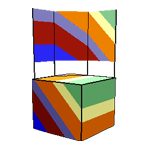 What is Apparent Dip?
Apparent dip is the inclination of geologic beds as seen from any vertical cross section not perpendicular to the strike of the geologic beds.
What is Apparent Dip?
Apparent dip is the inclination of geologic beds as seen from any vertical cross section not perpendicular to the strike of the geologic beds.
Note: When a vertical cross-section is perpendicular to the strike of the beds, the inclination seen in the cross section is called the true dip.
A Real World Example
Imagine you are skiing down a slope. If you went straight down the hill (the “fall-line”) you would be skiing in the true dip direction. Choose any other line, and you would be skiing in an apparent dip direction.
Notice that by choosing an apparent dip direction, you decrease the apparent steepness of the slope.
The apparent steepness in the direction of travel is the apparent dip in that direction (the cross-section direction). The hill is of course the geologic bedding plane.
Important Things to Keep in Mind
You can never have an apparent dip that is greater than the true dip.
If your cross section and bedding-strike are parallel, the apparent dip will be zero.
If you get a negative apparent dip, that means your cross-section is bearing in the up-dip instead of the down-dip direction; just take the absolute value.
Calculating Apparent Dip
To calculate apparent dip, use the following formulas:
or
Where
-
is the apparent dip,
-
is the true-dip of the beds,
-
is the strike of the beds,
-
is the true dip direction
, and
-
is the bearing of your cross-section.
